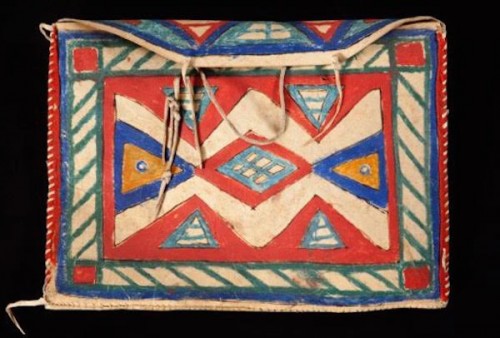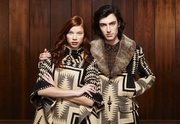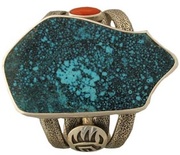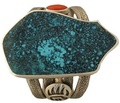Europeans and European Americans didn’t fully embrace abstract art until the early 20th century, when artists like Piet Mondrian and Ilya Bolotowsky used color, lines, and geometric forms as their means of expression. However, shapes in bold hues have long been a part of the visual language for Native Americans, centuries before their invaders got obsessed with color blocks.
Similarly, before Louis Vuitton steamer trunks became all the rage, Plains and Plateau tribes—who became increasingly nomadic as settlers encroached on their native lands—had mastered the art of beautiful luggage, or rawhide saddlebags known as “parfleche.” In the early 19th century, geometric designs were just etched into the parfleche, but starting in the mid-1800s, they were painted in vivid primary and secondary colors.
Recently, John Molloy, owner of his namesake gallery in Manhattan, hosted an exhibition called “Geometries,” that showed 19th-century Native American parfleche next to 20th-century Abstractionist paintings, which sparked our interest in the beautiful saddlebags. Even though the two traditions originated independently, Molloy cites scientific studies that show the colors and shapes of each evoke comparable emotional responses in viewers’ brains.

An Umatilla envelope parfleche, 15.5″ x 29″, from the late 19th century. (Courtesy of John Molloy Gallery)
Molloy explains that the tribespeople used rawhide for their baggage because it was only semi-tanned and would hold its shape. The decorating—using natural mineral paints or commercially purchased paints—had to be done as part of the tanning process, when the hide was still wet, which is akin to the fresco painting technique.
“What’s wonderful about the Native American form is that within this geometry that is somewhat specific, they have a tremendous area of innovation and creativity.”
“We did an interview with somebody who is making these parfleche now,” Molloy says. “He says you’ve got to paint it in the shade because otherwise the rawhide will dry too quickly and won’t absorb the paint. When you paint it while the hide is still wet, the paint is absorbed into the hide, so that when you’re using the bag, the color doesn’t get knocked off. It has a different quality to it than something that’s just been painted on the surface.”
Traditionally painted by the women of the tribes, parfleche were made as utilitarian objects for the Native Americans themselves to carry things like clothes, tools, food, and medicine on horseback—and as souvenirs sold to European Americans touring the West. A typical “envelope” parfleche would be roughly 12 inches wide and 26-27 inches tall. Smaller forms, known as “document cases,” are about 12 inches wide and 10 inches tall. Different tribes used different patterns of diamonds, triangles, rectangles, squares, and circles so that a Sioux parfleche would be distinct from that of a Crow.
“Parfleche designs might be similar to flags, but they don’t have a rigid geometry,” Molloy says. “What’s wonderful about the Native American form is that within this geometry that is somewhat specific, they have a tremendous area of innovation and creativity. It reminds me of the sonnet, with its 14 lines of iambic pentameter—a rigid form that has borne tremendous creativity. I think that the American Indian parfleche has done a similar thing.”

Crow horse-armor parfleche, circa 1880. (Courtesy of John Molloy Gallery)
(To learn more about Native American parfleche, read about the John Molloy Gallery exhibition here and here, as well as Aline Brandauer’s essay “Art on Horseback: Parfleche.” Also, pick up Gaylord Torrence’s book “The American Indian Parfleche: A Tradition of Abstract Painting.” If you buy something through a link in this article, Collectors Weekly may get a share of the sale. Learn more.)











 How Railroad Tourism Created the Craze for Traditional Native American Baskets
How Railroad Tourism Created the Craze for Traditional Native American Baskets
 Why the 'Native' Fashion Trend Is Pissing Off Real Native Americans
Why the 'Native' Fashion Trend Is Pissing Off Real Native Americans How Railroad Tourism Created the Craze for Traditional Native American Baskets
How Railroad Tourism Created the Craze for Traditional Native American Baskets Native American Jewelry Lowdown: The Story Behind Turquoise and Squash Blossoms
Native American Jewelry Lowdown: The Story Behind Turquoise and Squash Blossoms SuitcasesIn 18th-century Europe, leisure travel was only for the rich. Their servant…
SuitcasesIn 18th-century Europe, leisure travel was only for the rich. Their servant… Native American AntiquesThousands of years before America was “discovered,” Native Americans were c…
Native American AntiquesThousands of years before America was “discovered,” Native Americans were c… Fine ArtFor as long as there have been civilizations, humans have made art to inter…
Fine ArtFor as long as there have been civilizations, humans have made art to inter… Mari Tepper: Laying it on the Line
Mari Tepper: Laying it on the Line Nice Ice: Valerie Hammond on the Genteel Charm of Vintage Canadian Costume Jewelry
Nice Ice: Valerie Hammond on the Genteel Charm of Vintage Canadian Costume Jewelry How Jim Heimann Got Crazy for California Architecture
How Jim Heimann Got Crazy for California Architecture Modernist Man: Jock Peters May Be the Most Influential Architect You've Never Heard Of
Modernist Man: Jock Peters May Be the Most Influential Architect You've Never Heard Of Meet Cute: Were Kokeshi Dolls the Models for Hello Kitty, Pokemon, and Be@rbrick?
Meet Cute: Were Kokeshi Dolls the Models for Hello Kitty, Pokemon, and Be@rbrick? When the King of Comedy Posters Set His Surreal Sights on the World of Rock 'n' Roll
When the King of Comedy Posters Set His Surreal Sights on the World of Rock 'n' Roll How One Artist Makes New Art From Old Coloring Books and Found Photos
How One Artist Makes New Art From Old Coloring Books and Found Photos Say Cheese! How Bad Photography Has Changed Our Definition of Good Pictures
Say Cheese! How Bad Photography Has Changed Our Definition of Good Pictures Middle Earthenware: One Family's Quest to Reclaim Its Place in British Pottery History
Middle Earthenware: One Family's Quest to Reclaim Its Place in British Pottery History Fancy Fowl: How an Evil Sea Captain and a Beloved Queen Made the World Crave KFC
Fancy Fowl: How an Evil Sea Captain and a Beloved Queen Made the World Crave KFC
Absolutely beautiful